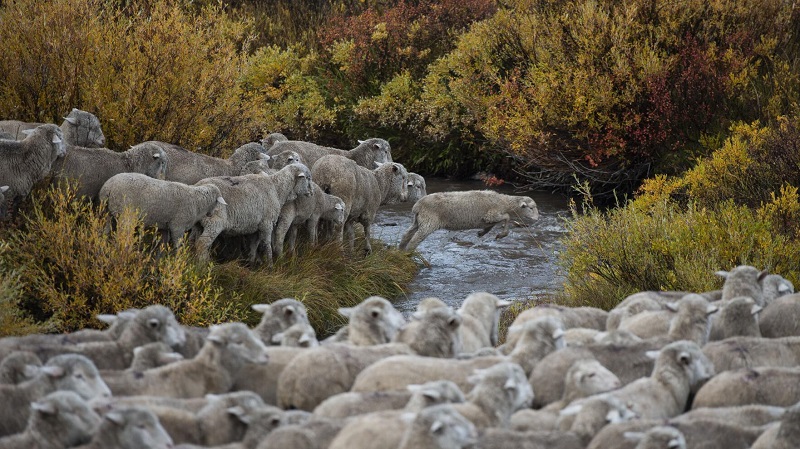Local News
$4 million grant is given to a Montana State research team to examine the relationships between domestic and wild sheep

Bozeman, Montana – Four million dollars in additional funding have been provided to a research team at Montana State University College of Agriculture [ag.montana.edu] to assist establish the foundation for managing and preventing disease in domestic and wild sheep throughout the state.
In MSU’s Department of Animal and Range Sciences [animalrange.montana.edu], assistant professor and Extension Wildlife Specialist Jared Beaver and MSU Extension [montana.edu] Sheep Specialist Brent Roeder will oversee a team that will investigate the frequency of interactions between wild bighorn sheep and domestic sheep. Their data collection will assist wildlife managers in formulating plans for adaptive management that will permit both species to coexist on Montana’s rangelands. Additionally, it will contribute to our understanding of how diseases propagate throughout populations.
“Being able to better predict when and where domestic and wild sheep are likely to interact will allow us to be more efficient with our time and resources,” said Beaver, whose research focuses on holistic wildlife management approaches. “It allows us to focus mitigation efforts in the highest-risk areas and potentially focus reintroduction in areas where transmission risk is very low.”
Montana Fish, Wildlife and Parks is the source of the funds, which will finance the research for a minimum of five years. They will also be working together on the project. In comparison to other reintroduced species like elk, bighorn sheep have exhibited less population recovery. Beaver stated that the work will benefit FWP in implementing its adaptive management plan for this species.
Beaver stated that various sheep producers in Montana, the Montana Woolgrowers Association, and the Montana Wild Sheep Foundation are among the other collaborators. One of the main objectives of the study was to include as many viewpoints as possible because it might be challenging to track the interactions between domestic and wild sheep.
“This project has important implications for many Montanans, from lamb and wool producers to wildlife enthusiasts and the hunting community,” said Carl Yeoman, head of the Department of Animal and Range Sciences. “It will be especially valuable having all stakeholders at the table in a co-production research framework.”
Roeder, who has spent more than 20 years researching wool quality and sheep production in Montana, believes the work will gain from taking into account a variety of viewpoints.
“This is the first study to my knowledge that has brought this many agencies together on this topic,” he said. “It’s a current issue that’s impacting a lot of domestic producers around the state.”
Mycoplasma ovipneumoniae, or M. Ovi, a microbe that can cause respiratory infections in sheep and goats and occasionally result in pneumonia, will be a special focus of the study. According to Roeder, the disease usually causes few symptoms in domestic herds, but in wild bighorn sheep herds, it can be fatal.
According to Beaver, management strategies and the reintroduction of bighorn sheep can be adjusted to reduce danger if the research can show patterns in the frequency and locations of interactions between wild and domestic sheep.
Beaver cited earlier studies that demonstrated a 14.5-kilometer (9-mile) buffer—that is, a space between wild and domestic herds—was sufficient to significantly minimize the spread of M. Ovi. That much space isn’t always possible to accommodate, though.
“Getting a better understanding of how contact is occurring and seeing if there are predictors for it means we can start to identify better tools than just a line on a map,” he said. “What a lot of other studies have lacked is that local and generational knowledge, so we wanted a study that properly evaluated co-mingling that also included all the stakeholders, where producers weren’t left out of those conversations.”
Radio collars are commonly used on wild animals so that migratory patterns may be monitored by scientists and wildlife management. According to Beaver, the new initiative will use collar data from bighorn sheep to determine the most likely or frequent locations for interaction.
The group will collaborate with sheep farmers in areas with greater traffic to develop methods for keeping domestic and wild sheep apart. According to Roeder, these tactics might involve employing sheepherders or livestock guard dogs, as well as seasonally rearranging pasture land by bighorn migration. Further research is needed to determine which tactics work best.
“The issue of respiratory disease in bighorn sheep has been the subject of a huge amount of work across the western U.S. and Canada for decades,” said Emily Almberg, a wildlife disease ecologist for Montana Fish, Wildlife and Parks and a member of the collaborative research team. “Approaches to this issue fall into two broad categories, one aimed at improving the performance of chronically infected herds and the other aimed at finding ways to minimize new contact events that can be devastating to bighorn populations. Our work falls in this latter category and has the potential to yield wins for both bighorn and domestic sheep health.”
The MSU team is hoping that the experiment will lead to fresh approaches to land and wildlife management, which will help the state’s farmers, as well as the domestic and wild sheep.
“This has been several years in the making,” said Beaver. “It’s not just an ecological or biological question. There are social and cultural components to it, which makes it very dynamic. That’s why we wanted a project built from the ground up that involved MSU and FWP, but also producers and landowners, because we will not capture a full picture without that diverse participation.”






Leave a Reply